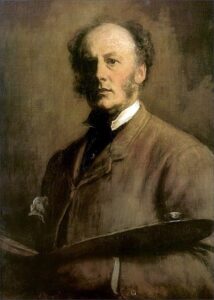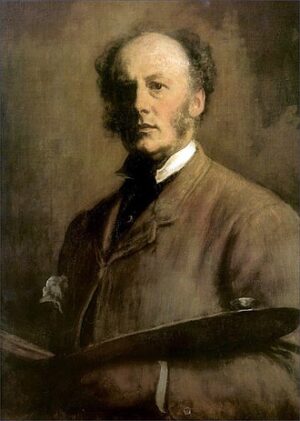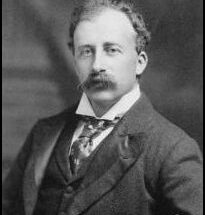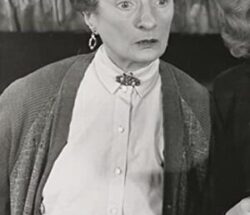
Early Life
John Everett Millais was born on June 8, 1829, in Southampton, England. His parents were John William Millais and Emily Mary Millais (née Evermy). Most of his early childhood was spent in Jersey, to which he retained a strong devotion throughout his life. The family moved to Dinan in Brittany for a few years in his childhood.
His mother’s “forceful personality” was the most powerful influence on his early life. She had a keen interest in art and music, and encouraged her son’s artistic bent, promoting the relocating of the family to London to help develop contacts at the Royal Academy of Art. John Everett later said “I owe everything to my mother.”
His artistic talent won him a place at the Royal Academy schools at the still unprecedented age of eleven. While there, he met William Holman Hunt and Dante Gabriel Rossetti with whom he formed the Pre-Raphaelite Brotherhood (known as the “PRB”) in September 1848 in his family home on Gower Street, off Bedford Square.
Pre-Raphaelite Period
Millais’s Christ in the House of His Parents (1849–50) was highly controversial because of its realistic portrayal of a working class Holy Family labouring in a messy carpentry workshop. Millais achieved popular success with A Huguenot (1851–52), which depicts a young couple about to be separated because of religious conflicts. He repeated this theme in many later works.
All these early works were painted with great attention to detail, often concentrating on the beauty and complexity of the natural world. In paintings such as Ophelia (1851–52) Millais created dense and elaborate pictorial surfaces based on the integration of naturalistic elements. This approach has been described as a kind of “pictorial eco-system.”
Mariana is a painting that Millais painted in 1850–51 based on the play Measure for Measure by William Shakespeare and the poem of the same name by Alfred, Lord Tennyson from 1830. In the play, young Mariana was to be married, but was rejected by her betrothed when her dowry was lost in a shipwreck.
This style was promoted by the critic John Ruskin, who had defended the Pre-Raphaelites against their critics. Millais’s friendship with Ruskin introduced him to Ruskin’s wife Effie. Soon after they met, she modelled for his painting The Order of Release. As Millais painted Effie, they fell in love. Despite having been married to Ruskin for several years, Effie was still a virgin. Her parents realised something was wrong and she filed for an annulment.
Family life & Academic career
In 1853, Millais was elected as an associate member of the Royal Academy of Arts, and was soon elected as a full member of the Academy, in which he was a prominent and active participant.
In 1855, after the marriage to Ruskin was annulled, Effie and John Millais married. He and Effie eventually had eight children: Everett, born in 1856, George, born in 1857, Effie, born in 1858; Mary, born in 1860, Alice, born in 1862, Geoffroy, born in 1863, John in 1865, and Sophie in 1868.
Their youngest son, John Guille Millais, became a naturalist, wildlife artist, and Millais’s posthumous biographer. Their daughter Alice was a close friend and muse of the composer Edward Elgar, and is thought to have been an inspiration for themes in his Violin Concerto.
Later life & work
After his marriage, Millais began to paint in a broader style, which was condemned by Ruskin as “a catastrophe.” It has been argued that this change of style resulted from Millais’s need to increase his output to support his growing family. Unsympathetic critics such as William Morris accused him of “selling out” to achieve popularity and wealth.
His admirers, in contrast, pointed to the artist’s connections with Whistler and Albert Moore, and influence on John Singer Sargent. Millais himself argued that as he grew more confident as an artist, he could paint with greater boldness. Paintings such as The Eve of St. Agnes and The Somnambulist clearly show an ongoing dialogue between the artist and Whistler, whose work Millais strongly supported.
Other paintings of the late 1850s and 1860s can be interpreted as anticipating aspects of the Aesthetic Movement. Many deploy broad blocks of harmoniously arranged colour and are symbolic rather than narratival.
From 1862, the Millais family lived at 7 Cromwell Place, Kensington, London. Millais was also very successful as a book illustrator, notably for the works of Anthony Trollope and the poems of Tennyson. His complex illustrations of the parables of Jesus were published in 1864. He also provided illustrations for magazines such as Good Words.
Paintings from the 1870s onwards demonstrate Millais’s reverence for Old Masters such as Joshua Reynolds and Velázquez. Many of these paintings were of an historical theme. Notable among these are The Two Princes Edward and Richard in the Tower (1878) depicting the Princes in the Tower, The Northwest Passage (1874) and the Boyhood of Raleigh (1871).
Such paintings indicate Millais’s interest in subjects connected to Britain’s history and expanding empire. He also achieved great popularity with his paintings of children, notably Cherry Ripe (1879) and Bubbles (1886). His last project (1896) was to be a painting entitled “The Last Trek.” Based on his illustration for his son’s book, it depicted a hunter lying dead in the veldt, his body contemplated by two onlookers.
In July 1885, Queen Victoria created him a baronet of Palace Gate, in the parish of St Mary Abbot, Kensington, making him the first artist to be honoured with a hereditary title. After the death of Lord Leighton in 1896, Millais was elected President of the Royal Academy.
Landscapes
In 1870 John Millais returned to full landscape pictures, and over the next twenty years painted a number of scenes of Perthshire where he was annually found hunting and fishing from August until late into the autumn each year. Most of these landscapes are autumnal or early winter in season and show bleak, dank, water-fringed bog or moor, loch, and riverside.
Millais never returned to “blade by blade” landscape painting, nor to the vibrant greens of his own outdoor work in the early fifties, although the assured handling of his broader, freer later style is equally accomplished in its close observation of scenery.
Many were painted elsewhere in Perthshire, near Dunkeld and Birnam, where Millais rented grand houses each autumn to hunt and fish. Christmas Eve, his first full landscape snow scene, painted in 1887, was a view looking towards Murthly Castle.
Death
John Everett Millais died on 13 August, 1896, in Kensington from throat cancer at the age of 67. He was buried in the crypt of St Paul’s Cathedral. After his death the Prince of Wales (later to become King Edward VII) chaired a memorial committee which commissioned a statue of the artist. The statue, by Thomas Brock, was installed at the front of the National Gallery of British Art (now Tate Britain) in the garden on the east side in 1905.



